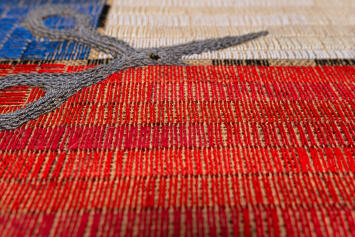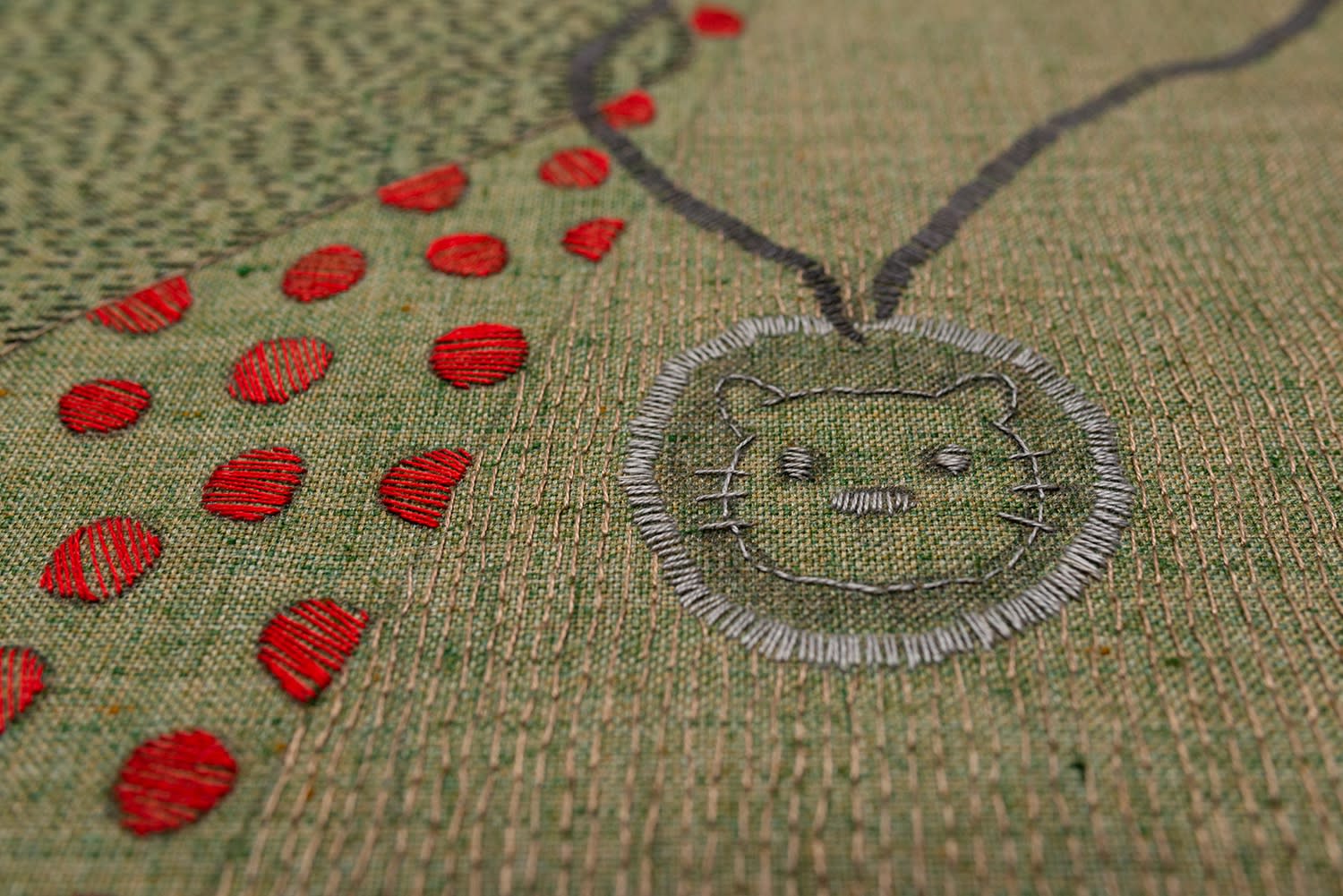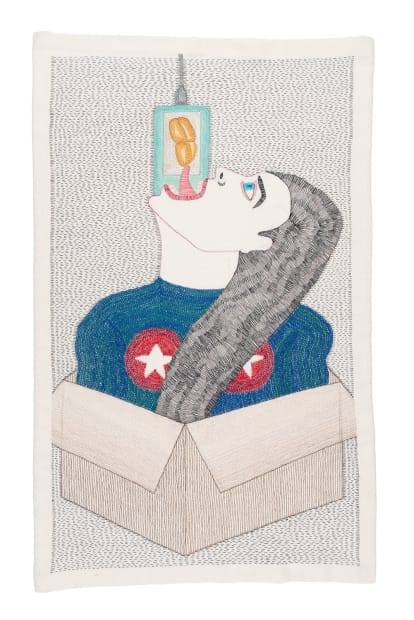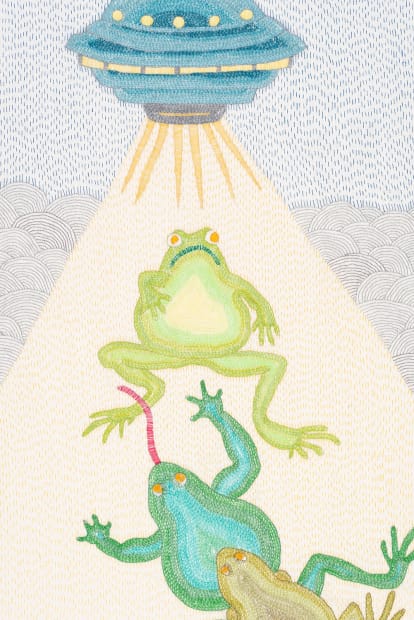Isabel Croxatto Galería is pleased to present the solo exhibition EX POST by Chilean textile artist Paloma Castillo. The exhibition gathers her most recent work: a series of 20 hand embroideries, created under the concept ex post (after the fact), due to the influence that the news of the social unrest in Chile, the pandemic, and the confinement, has had on her work.
"Castillo's work does not only involve the transition from oil to cotton thread, from brush to needle, and from brushstroke to stitch, but it is actually a technical revolt that disorganises the patterns of artistic production, weaving textual disorders and reading paradoxes."
—José Salomon Gebhard, November 2020.
-
 Detail of the piece Madame, 2020, Hand embroidery with cotton thread on jute
Detail of the piece Madame, 2020, Hand embroidery with cotton thread on juteI never thought that embroidery would be the means by which to express myself, despite coming from mother and grandmother, excellent designer and seamstress.
—Paloma Castillo
-
Embroidering Paradoxes
Curatorial text by José Salomon GebhardThis exhibition, Ex Post, reaffirms the spectator's discomfort in front of Paloma Castillo's artistic production, which urgently challenges us to mess up and disarrange our already worn-out routine of looking at, and understanding art.
Paloma Castillo's artistic production emerges from a systematic desire to express the paradoxical as an interpretative key to her work. In fact, her production discusses its own place of emergence in the disciplinary margins of art; it will no longer be called artistic production only, but also textile work or simply embroidery, as a shapeless set of fabrics and textiles, in open confrontation with the most conservative aesthetic canons of art. Without falling into avant-garde militancy, Castillo's embroideries challenge the institutional rigour of art, even the most progressive, from the place assigned to the minority and marginal nature of textile production, outside of all academic consecration and museum legitimacy. Nevertheless, the desire for the paradoxical in Castillo's work confronts both the hegemonic field of art and the socially assigned place that identifies the popular with the superfluous and the banal; it avoids its own self-designation as a work of art and, at the same time, as a work of folk nature. The first paradox, which destabilises the position of the observer of the artwork: which is the legitimate place of Paloma Castillo's embroidery, an exhibition hall, a gallery or the privacy of the home? The answer opens the traditional debate about the ornamental nature of certain artistic production, but does not close the discussion by appealing to the embroidery's aesthetic enjoyment. On the contrary, her production avoids both the sentimental naivety of popular art and the sophisticated reflection of cultured art. On the other hand, in Castillo, the ornamental no longer remains in the object representation of the painting only, but shifts to the materiality of the work, to the language that encodes the embroidered object, transforming the textile material, the needle, the wool, into the naive elements of cultured art and making possible a sophisticated reflection on the popular in the art. It is thus a paradox that destroys the chiasm that assimilates the easy to the popular and the complex to the cultured, reinventing language as a matter of representation and the embroidered object as a means of expression.
In the textile evidence of the embroidery, Paloma Castillo protects the contradiction as an aesthetic operation, displacing the literal sense of the objects that she weaves, beyond any conventional reading that restricts the interpretative precariousness of her figures. Why not assume, then, that Castillo seeks to overcome realism in the embroidery tradition, as if this art, cornered in the hovel of the feminine, could not be conceptualised with the theoretical apparatus of the male atelier. Castillo's work does not only involve the transition from oil to cotton thread and from brush to needle, from brushstroke to stitch, but it is actually a technical revolt that disorganises the patterns of artistic production, weaving textual disorders and reading paradoxes. The embroidery also turns against itself, as a counter-embroidery that questions the usefulness of a wool iron or plug, or the aesthetic value of a still life composed of a skull, bread and a sling. The representation of the domestic, of the popular, of the feminine, is altered when it enters the embroidered work because its language of enunciation distorts the objectivity that is represented. A fire that does not burn, portraits without identity, razor blades that do not cut, eyes that do not see and hearts that do not feel, have made the space of the domestic the location of otherness, also provoking a strangeness of the everyday.
Paradoxes with no solution, but neither do they pretend to be solved by artistic formulas or mathematical spells, since Paloma Castillo's work insists on affirming the unstable place of unresolved doubt, of the uselessness of a cotton knife. Thus, the embroidered glass does not appeal to the folklore of the everyday, but rather constitutes the staging of a code whose function is to alter its senses, a highly specialised expressive gesture, a code that intensifies the tension between the functionality of the object (what can a cotton glass be used for?) and its linguistic materiality, its cotton language. Paradoxes of representation.
As a whole, Paloma Castillo's embroideries encourage us to reverse the task of the spectator and their habits of observation, disarming the logic of any sequential and reasoned reading, of any hierarchy that systematises the signs of the work seen. In the apparent naivety of embroidery, Castillo's artistic production encourages us to observe with the easy joy of textile work, with the plain simplicity of the needle and thread, as if life were a matter of song and dance, according to an old Hispanic saying. But the complex weave, the unexpected texture and the unusual stroke deeply move us, to the point of provoking the uncertainty of paradox, the irrational shock of unanswered questions.
This exhibition, Ex Post (after the fact), reaffirms the spectator's discomfort in front of Paloma Castillo's artistic production, which urgently challenges us to mess up and disarrange our already worn-out routine of looking at, and understanding art.
José Salomon Gebhard | November 2020
-
-
-
-

-
-
 Paloma CastilloCompañero, 2020Hand embroidery with cotton threads on jute50 x 38.5 cmSoldView more details
Paloma CastilloCompañero, 2020Hand embroidery with cotton threads on jute50 x 38.5 cmSoldView more details -
 Paloma CastilloMolotov, 2020Hand embroidery with cotton threads on jute52 x 39 cmSoldView more details
Paloma CastilloMolotov, 2020Hand embroidery with cotton threads on jute52 x 39 cmSoldView more details -

-
 Paloma CastilloConferencia, 2020Hand embroidery with cotton threads on linen66 x 42 cmSoldView more details
Paloma CastilloConferencia, 2020Hand embroidery with cotton threads on linen66 x 42 cmSoldView more details
-
 Paloma CastilloMadame, 2020Hand embroidery with cotton threads on linen64 x 40 cmSoldView more details
Paloma CastilloMadame, 2020Hand embroidery with cotton threads on linen64 x 40 cmSoldView more details -

-
 Paloma CastilloLa Cocinera de Palacio, 2020Hand embroidery with cotton threads on linen88 x 59 cmSoldView more details
Paloma CastilloLa Cocinera de Palacio, 2020Hand embroidery with cotton threads on linen88 x 59 cmSoldView more details -
 Paloma CastilloUbicado, 2020Hand embroidery with cotton threads on jute52 x 41 cmSoldView more details
Paloma CastilloUbicado, 2020Hand embroidery with cotton threads on jute52 x 41 cmSoldView more details
-
 Paloma CastilloIdentificado, 2020Hand embroidery with cotton threads on cotton fabric84 x 52 cmSoldView more details
Paloma CastilloIdentificado, 2020Hand embroidery with cotton threads on cotton fabric84 x 52 cmSoldView more details -
 Paloma CastilloAbducidos, 2020Hand embroidery with cotton threads on cotton fabric87 x 53 cmSoldView more details
Paloma CastilloAbducidos, 2020Hand embroidery with cotton threads on cotton fabric87 x 53 cmSoldView more details -
 Paloma CastilloLa Caja, 2020Hand embroidery with cotton threads on cotton fabric88 x 54 cmSoldView more details
Paloma CastilloLa Caja, 2020Hand embroidery with cotton threads on cotton fabric88 x 54 cmSoldView more details -
 Paloma CastilloEl Príncipe, 2020Hand embroidery with cotton threads on jute52 x 39 cmSoldView more details
Paloma CastilloEl Príncipe, 2020Hand embroidery with cotton threads on jute52 x 39 cmSoldView more details
-
 Paloma CastilloEspacio I, 2020Hand embroidery with cotton and silk threads on jute52 x 41 cmSoldView more details
Paloma CastilloEspacio I, 2020Hand embroidery with cotton and silk threads on jute52 x 41 cmSoldView more details -
 Paloma CastilloEspacio II, 2020Hand embroidery with cotton threads on jute52 x 41 cmSoldView more details
Paloma CastilloEspacio II, 2020Hand embroidery with cotton threads on jute52 x 41 cmSoldView more details -
 Paloma CastilloEl Olimpo I, 2020Hand embroidery with cotton threads on jute52 x 39 cmSoldView more details
Paloma CastilloEl Olimpo I, 2020Hand embroidery with cotton threads on jute52 x 39 cmSoldView more details -
 Paloma CastilloLa Tierra I, 2020Hand embroidery with cotton threads on jute52 x 41 cmSoldView more details
Paloma CastilloLa Tierra I, 2020Hand embroidery with cotton threads on jute52 x 41 cmSoldView more details
-






























